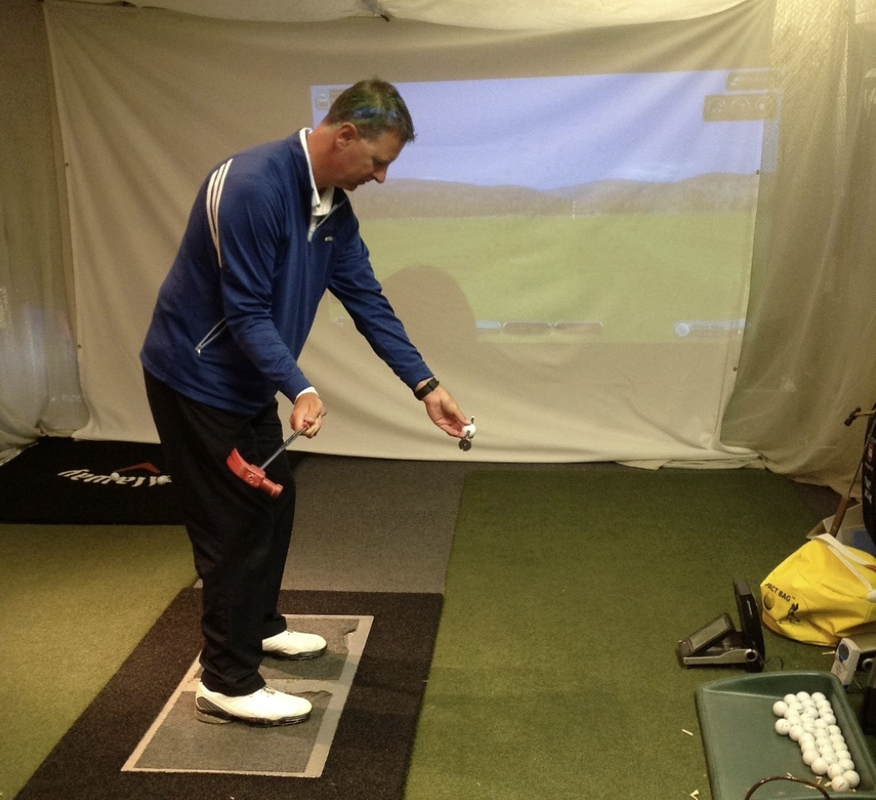THE SCIENCE BEHIND THE SWING by TONY LUCZAK, PGA

The purpose of this chapter was to investigate previous literature concerning the muscle activation patterns of the full golf swing. This chapter is divided into three major sections. The first two sections include arm kinematics in the forward and acceleration phases of the golf swing, muscle activation patterns of the upper extremities in the forward and acceleration phases of the golf swing, while the final section investigates the application of using modified practice procedure to elicit improved coordinated motor control during the golf swing.
ARM KINEMATICS DURING FORWARD AND ACCELERATION PHASE OF THE GOLF SWING
The golf swing is a very complex neuromotor task which has been analyzed by separating the motion into different phases. These phases include the back swing, which is from the ball address to the top of the back swing, the forward swing, which is from the top of the back swing to when the club shaft is horizontal to the ground, the acceleration phase, which is the end of the forward swing to impact (club/ball contact), the early follow through, which is at impact to when the golf club shaft is horizontal to the ground, and the late follow through, which is from the end of the early follow through completion of the swing (McHardy & Pollard, 2005). The goal of the golf swing is to produce a specific golf club head velocity and club face alignments applied to the ball that matches the intended shot from the player (Langdown et al., 2012). How a golfer develops this skill is still being debated and scrutinized. Generally, golfers are often taught to acquire and control kinematic patterns or discrete positions of professional golfers and through anecdotal information from current and former players as learning models as illustrated in many coaching manuals such as the PGA of America(Bradshaw et al., 2009; Knight, 2004; Langdown et al., 2012). However, several concerns with kinematic based instructional approaches are the variety of golf shots that are required on the golf course and individual physical factors that may not match range of motion or strength capabilities of an expert model. An example of kinematic patterns being applied as an instructional technique is how golfers can generate high club head speeds through the rotational speed of the hips. Teaching professionals often use “segment separation” or “x-factor”, which is the difference in the degrees of rotation of the upper torso and pelvis kinematics at the top of the backswing to describe the mechanics that create maximum driving distance (McLean, 1997; Myers et al., 2008). The support for their approach is that of proximal to distal sequencing, which is apparent in various throwing and hitting motions, where motion from larger, slower moving body segments transfer their energy to smaller and lighter segments, to produce distal speed (Bunn, 1972; Kreighbaum & Barthels, 1985; N. Marshall & Elliott, 2000; Robertson & Mosher, 1985; Zernicke & Roberts, 1976). The principle of summation of speed has been used to describe the proximal-to-distal segmental sequencing that occurs in throwing and striking movements, however, the principle does not present the mechanics of how the system works (Putnam, 1993). The development of a clearer understanding of proximal-to-distal sequencing has been described by Putnam (1993) as “the distal segment is subsequently accelerated forward primarily by the interactive moment resulting from the angular velocity of the proximal segment and by the joint moment at the proximal end of the distal segment”, which when applied to the golf swing is the right arm (right handed golfer) begins its acceleration from the proximal musculature of the brachium performing adduction and internal rotation (shoulder joint), antebrachium extending (elbow joint) , and hands moving from extension to flexion and deviation (writs joints) in the forward and acceleration phases of the golf swing. Thus, the movement of the torso minimally contributes to the velocity of the arms and it’s role is to position the proximal segment (arms) to create alignments allowing distal end segments to move at high speedsbased on their muscular activation (Putnam, 1993). Furthermore, in Myers etl al. (2008) study of 100 golfers of various handicap levels looking into the upper torso and pelvis rotation during the golf swing, it was stated that “a cause-effect mechanism (i.e. increased torso-pelvic separation causes increased ball velocity) was not established”. Therefore, current teaching methodologies that emphasize pelvis and torso rotation velocities to create club head speed are inaccurate.
Additional research by Nesbit & Serrano (2005), reported an analysis of work and power of the golf swing, stated that the arms play a dual role in work generation and control of the club in angular work, linear work, and linear power. This study reported that the arms are more important in generating power applied to the golf club and that the work of the body is mostly used to position the body for optimal arm and club impact alignments not to transfer speed to the club (Nesbit & Serrano, 2005). Further analysis of upper body kinematics revealed that 72 healthy male golfers separated into 4 groups, tour professional (PRO), low handicap (LH), mid handicap (MH) and high handicap (HH) indicated greater internal rotation velocity from the right shoulder, right and left elbow extension, and right and left wrist angular velocity occurred in PRO and LH groups which attributed to an increase in club shaft velocity (Zheng, Barrentine, Fleisig, & Andrews, 2008). Interestingly, Zheng et al. (2008a) reported, even though not significant, was that middle and higher handicap golfers had higher angular trunk rotation velocities than the lower handicap and professional golfers, thus it appears that it is not the speed of trunk rotation that creates club head speed, but proper upper limb kinematic movement patterns. This also has been identified in squash forehand strokes, which mimic the acceleration phase of the golf swing, that forward racket-shoulder (gleno-humeral joint) mean contribution was only 4.9%, upper arm internal rotation contributed 46.1%, forearm pronation 12.0%, and wrist flexion 18.2% to horizontal velocities of the racket (Elliott, Marshall, & Noffal, 1996).
In addition, how the arms and body segments are utilized in the forward and acceleration phases of the golf swing have a significant influence on the quality of golf club delivery into impact. Utilizing an arms club systems approach will allow each golfer the opportunity to move their body in response to the intended hand and club path, adapting for individual anatomical and mobility differences (Knight, 2004). This motor control approach offers individualized multiple movements patterns compared to an invariant kinematic positioning or body specific movement patterns such as pelvis-torso rotation. This approach can be seen in Kwon et al. (2012) analysis that described the movement of the golf club head is not a fixed plane but as a “helical trajectory” until the club reaches the acceleration phase, which then shifts into a “functional swing plane” (FSP), formed by the club head trajectory during the acceleration phase through impact and into early follow through phase. When the arms initiate the movement of the golf club from the top of the backswing into the forward swing, this keeps the golf club in a “semi-planar” position allowing for more efficient delivery into the FSP, however, when the torso rotation and linear shoulder motion is utilized in the forward phase this tends to promote a “spiral swing” making it difficult to get the golf club back to the FSP and ball (Kwon et al., 2012). This independent arm motion has also been reported in golfers of various skill levels and genders showing a reduction of segment movement variability as the club head approaches the golf ball, with the club head and hand trajectories being the most consistent (Evans & Tuttle, 2015; Horan, Evans, & Kavanagh, 2011). Instead of focusing on specific back swing phase alignments and body oriented movement, it seems appropriate to focus on the arm segments that create optimal golf club control in the forward and acceleration phases of the golf swing which are critical to generating proper golf club/ball impact variables in centeredness of impact, club head velocity, and club head orientation that significantly influence ball flight direction and distance (Sweeney, Mills, Alderson, & Elliott, 2013).
MUSCLE ACTIVATION PATTERNS IN THE UPPER EXTREMETIES IN THE FORWARD AND ACCELERATION PHASES OF THE GOLF SWING
The use of electromyography (EMG) may offer additional insight into the neuromotor mechanisms that drive the golf swing. EMG evidence that the arms are a main contributor to forward and acceleration phase control has been reported by Jobe, Perry, & Pink (1989) study of 6 men and 7 women professional golfers in that both male and female golfers reported combined right pectoralis major (PM) activation of 64% and left PM 18% during the forward swing and increasing to 93% PM bilaterally during the acceleration phase as a percentage of their manual muscle test. Evidence that the right arm plays a key role in delivering the golf club is that the pectoralis major is the most active than any other muscle tested by Pink, Jobe, & Perry (1990), which provides power to the swing through adduction and internal rotation. These findings seem to indicate that golf instructional methodologies need to be reassessed and possibly be based on learning strategies that mimic proper muscle activation patterns not just kinematic observation. The benefit of EMG analysis may also provide an opportunity for injury prevention, rehabilitation, and avoidance of style based instructional methodologies that may not be effective (McHardy & Pollard, 2005).
MOTOR CONTROL IN THE GOLF SWING
As previously discussed, observational kinematics of the golfer and golf club generally do not offer insight into the neuromotor mechanisms that created the movement. Thus, the use of motor control and motor learning strategies that emphasize golf club impact conditions should be prioritized during instruction (Knight, 2004; Langdown et al., 2012). This motor control approach coincides with how the arms initiate the movement of the club at the top of the backswing into the forward and acceleration phases of the golf swing to improve contact. According to Knight (2004), instead of emphasizing specific positions during the golf swing, focusing on the path of the club head during forward and acceleration phase offers a more complete approach towards motor learning. Thus, any instructional advice should focus on the golf club and the arm segments that control the movement during the swing. A potential practice technique which would enable the golfer to create the desired motor patterns and reduce body segmental degrees of freedom is to make golf swings in a modified one-legged stance position. The modified one-legged stance practice is based on a systems approach which allows the golfer to discover or learn the muscle coordination patterns that create optimal control of the club head trajectory through the use of the arms and wrists (Bernstein, 1967; Knight, 2004). Thus, unlike traditional golf instruction that emphasizes body kinematics, like that of pelvis and torso rotational velocities to generate power in the golf swing, the focus on the club trajectory through the use of the arms, especially the right arm for a right handed golfer, promotes optimal delivery of the club into impact and results in improved body positioning and coordination (Knight, 2004). This exercise may challenge the central nervous system to develop individually coordinated muscle activation patterns to control the arm swing and golf club while maintaining balance to create optimal contact with the golf ball.



 RSS Feed
RSS Feed